
Trafalgar is a cape situated in Cadiz province. Its name comes from Arabic Taraf-al-Gharb which means Western Cape. It is a charming place with wide beaches, which during the winter are almost completely free of tourists, offer beautiful sunsets, and, of course, the most important building – Faro D’Trafalgar lighthouse – a solid 34 m tall construction built 55 years after the battle. The main road to the lighthouse is being regularly covered by sand from the nearby dunes, which seem to want to bury all routes leading to the end of the cape…
The strong wind, which often blows here, brings a smile to sun-kissed faces of kite-surfers, and at nights, it brings back the echoes of the battle from 21 October 1805. On that day, 21 miles from the coastline, there was a naval battle – one of the most important battles of Napoleonian period – between British and French-Spanish fleets. It is remembered as the Battle of Trafalgar.
It was the last great battle of sailing ships, and for the next 200 years, it established British hegemony on the seas. The fleets were commanded by Horatio Nelson (on the British side) and Pierre Villeneuve (commanding the united Spanish-French fleet). The bloody battle was won by the British, but their admiral, Nelson, was mortally wounded by a bullet from a musket, during his cheerful walk on the deck of his ship. A legend says that Horatio Nelson’s body, first, was taken to Rosia Bay in Gibraltar, and then, it was put into a rum barrel and transported to London for the funeral. Since then, rum is called Nelson’s Blood, because the transport was kept a secret and unaware sailors happily drank from this barrel… According to official sources, the barrel hiding the body was filled with a mix of brandy, camphor and myrrh.
The result of the battle was tragic for the French and the Spanish. They lost 22 ships, 3500 people died, about 2500 were wounded and about 7000 sailors were taken as prisoners. The British did not manage to tug the taken ships to Gibraltar waters. Many of the ships went under. Among the lost ships, there was the Spanish Santisima Trinidad – the largest sailing ship of the time. The raging storm completed the destruction by sinking and crashing the ships on the rocks. For the winners, the results of the battle were quite good. The British did not lose a single ship and the number of the dead was only 449 people.
The victory made it possible for the Brits to rule over seas and oceans. It also contributed to the establishment of the British Empire. After Nelson’s death, he became a national hero of the Great Britain and he is a part of the national ethos.
Here is what Santisima Trinidad – the largest ship of the epoch – looked like.
The picture in the title comes from Polish Wikipedia: trans. The battle of French ship Bucentaure against HMS Temeraire, Trafalgar (?), Auguste Mayer (1806 – 1890).
Un Saludo:)!
Back
Related articles